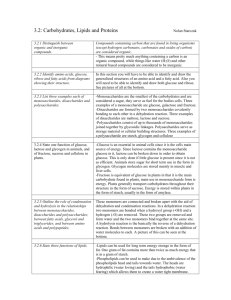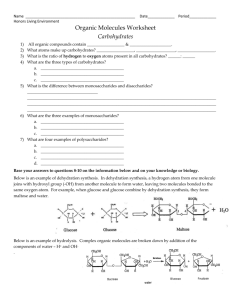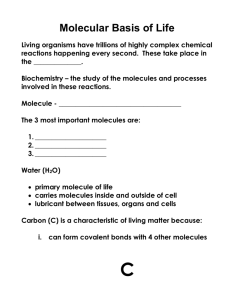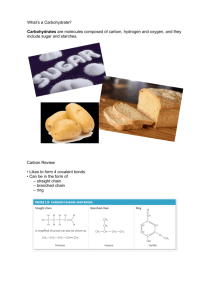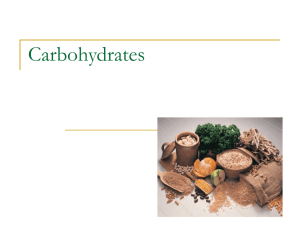1Introduction
advertisement
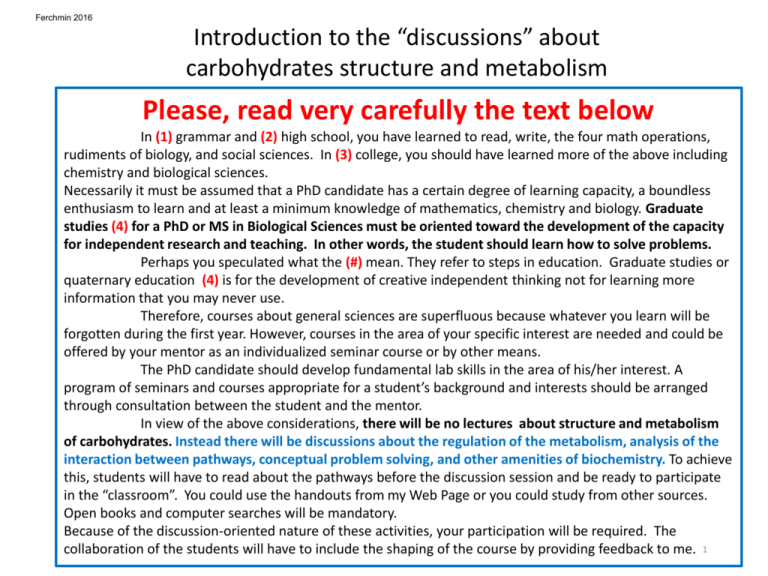
Ferchmin 2016 Introduction to the “discussions” about carbohydrates structure and metabolism Please, read very carefully the text below In (1) grammar and (2) high school, you have learned to read, write, the four math operations, rudiments of biology, and social sciences. In (3) college, you should have learned more of the above including chemistry and biological sciences. Necessarily it must be assumed that a PhD candidate has a certain degree of learning capacity, a boundless enthusiasm to learn and at least a minimum knowledge of mathematics, chemistry and biology. Graduate studies (4) for a PhD or MS in Biological Sciences must be oriented toward the development of the capacity for independent research and teaching. In other words, the student should learn how to solve problems. Perhaps you speculated what the (#) mean. They refer to steps in education. Graduate studies or quaternary education (4) is for the development of creative independent thinking not for learning more information that you may never use. Therefore, courses about general sciences are superfluous because whatever you learn will be forgotten during the first year. However, courses in the area of your specific interest are needed and could be offered by your mentor as an individualized seminar course or by other means. The PhD candidate should develop fundamental lab skills in the area of his/her interest. A program of seminars and courses appropriate for a student’s background and interests should be arranged through consultation between the student and the mentor. In view of the above considerations, there will be no lectures about structure and metabolism of carbohydrates. Instead there will be discussions about the regulation of the metabolism, analysis of the interaction between pathways, conceptual problem solving, and other amenities of biochemistry. To achieve this, students will have to read about the pathways before the discussion session and be ready to participate in the “classroom”. You could use the handouts from my Web Page or you could study from other sources. Open books and computer searches will be mandatory. Because of the discussion-oriented nature of these activities, your participation will be required. The collaboration of the students will have to include the shaping of the course by providing feedback to me. 1 Note I will appreciate if you bring to my attention any errors (not all, please) you may find in my handouts. Suggestions for improvement are always welcomed. The best way to communicate with me is at: ferchmin@gmail.com For safety reasons I do not check pedro.ferchmin@uccaribe.edu I neither agree, disagree, acknowledge or check whatever is posted about me in www.ucaribe.edu 2 THE STRUCTURE OF CARBOHYDRATES The objectives of this presentation is to motivate you to “think molecular”; to review concepts learned in organic chemistry and familiarize yourself with the carbohydrate molecules involved in metabolism. Summary of this presentation: 1) Definition of carbohydrate. 2) Asymmetric carbon, Fischer projection formulas. 3) D and L series. 4) Mutarotation, Haworth formulas and anomers. 5) Examples of monosaccharides. Fructose, mannose, galactose, deoxysugars, aminosugars, glucuronic and gluconic acids. 6) Glycosides and disaccharides. Lactose, maltose, isomaltose, cellobiose, sucrose 7) Homo- and heteropolysaccharides. Glycogen !!!! 8) Glycosaminoglycans (formerly called mucopolysaccharides). 3 Functions of carbohydrates Energy Glucose is the circulating sugar in blood and the energy source for most organs. Glycogen is one of the most important energy stores. Oxidation of glucose to CO2 and H2O is the central energy yielding process. Structural Polysaccharides are used as shock absorbers and lubricants in joints and as adhesives between cells. Signaling Sugars associated with proteins or lipids are involved in cell signaling. Sugars are involved in cell-cell interactions, immunological responses and determine the metabolic role of many proteins. Carbohydrates are polyalcohols of ketones or aldehydes and simple derivatives (like carboxylic acids or amino sugars), and polymers. Carbohydrates can be considered as 'carbon hydrates', the empirical formula is Cn(H2O)n. There is one water molecule per carbon atom. Carbohydrates are also called sugars or saccharides. The thousands of different carbohydrates found in nature are stereoisomers, derivatives or polymers of a rather small number of monosaccharides. For that reason, the concept of isomerism is important to understand carbohydrates. 4 Stereoisomery of carbohydrates is produced by the asymmetric carbon. The asymmetric carbon is tetrahedral and has 4 ≠ substituents. These three pictures show molecules that are enantiomers or mirror images of each other 5 To make it easier to write Fischer made the Fischer convention: You must apply it to each and all the asymmetric carbons of a molecule. Or to make it simpler you may use the projection formula 6 The smallest sugars with an asymmetric carbons are shown below: Conceptually speaking D-glyceraldehyde originates the series of D-carbohydrates, and reciprocally L-glyceraldehyde the L series. 7 Aldoses are derivatives of glyceraldehyde 8 The asymmetric carbons in a hexose have to be viewed one by one. Glucose is a carbohydrate of 6 carbons 9 Asymmetric carbons rotate polarized light: Ordinary light vibrates in all possible planes. When ordinary light is filtered by certain crystals a single plane of polarized light is obtained. Polarized light traveling through a solution of an asymmetric compound, such as sugar, can rotate the plane of polarized light. The degree of rotation is directly proportional to the concentration of the asymmetric compound. Substances that rotate the plane of polarized light are called "optically active." Rotation to the left is indicated as l and to the right as d. Contrary to intuition the levo or dextro rotation provides no clue whether a sugar is from the L or D series. Confusion comes from the fact that D-glyceraldehyde was originally designated D because it rotated the polarization plane +13.5º degrees and L-glyceraldehyde because it rotated -13.8º degrees to the left. Each asymmetric carbon of a molecule has its own contribution to the total rotation of polarized light. 10 Ketoses are derivatives of dihydroxyacetone 11 MUTAROTATION 12 Pyranoses and furanoses The terms pyranose and furanose come from the ‘similarity’ to pyran and furan to the rings formed by mutarotation. - D-Glucopyranose β- D-Fructofuranose 13 -D-Glucopyranose β-D-Glucopyranose 63% 36% <1% β-D-Glucofuranose <1% 0.1% -D-Glucofuranose 14 There are three manners to write the formula of monosaccharides. This actually represents how our concept of structure evolved 15 We will be repeating several concepts and practice them: Enantiomers are mirror images of each other; see below D- and L-glucose. We will need this concept to understand certain molecules 16 Chair model of glucose showing the axial and equatorial substituents. β anomer C5 is L. Therefore C6 is below the ring Since this is an L series sugar all is ≠ and anomeric –OH is above ring and it is anomer 17 Mutarotation in the case of fructose 18 The case of galactose 19 Ribose and “derivatives” of carbohydrates 2-[18-F] Fluoro-2-deoxy-D-glucose (FDG) 2-deoxy-D-glucose is a non metabolizable form of glucose and its 18-F derivative is used for imaging. 20 Reducing and nonreducing monosaccharides C1 of aldoses or C2 of ketoses is prone to be oxidized at the expense of other compounds including a reagents containing a cupric salt. Monosaccharides are reducing when their reducing C is free or in the form of hemiacetal 21 GLYCOSIDES Acetals are not reducing because they are not in equilibrium with the open form and there is no carbonyl group to be oxidized. Acetals between monosaccharides and non-carbohydrate molecules are called glycosides. Acetals between monosaccharides are called mono, di, tri or polysaccharides What can you say about this monosaccharide? Ouabain is an inhibitor of the sodium/ potassium pump Ouabain 22 Sugar chains are often linked to proteins by glycosidic bonds as shown below: This is an O glycosidic bond This is a N glycosidic bond All nucleosides and nucleotides are N-glycosides of ribose or deoxyribose and the corresponding purine or pyrimidine. 23 Disaccharides: are dimers of monosaccharides, either aldoses or ketoses You must be acquainted with: maltose, isomaltose, lactose, sucrose and cellobiose. Repeating unit in starch and glycogen. Notice the bond Repeating unit at branching points in starch and glycogen. Notice the bond. It is present in milk Glucose is the reducing monosaccharide. Notice the β bond. Repeating unit in cellulose. Notice the β bond. Sucrose is not a reducing monosaccharide. The bond is glucose 1 →fructose 2β. Sucrose accounts for 15% of the calories in our diet. It is the main cause of dental cavities, contributes to obesity and diabetes 24 POLYSACCHARIDES Homopolysaccharides are polymers of the same monosaccharide. Heteropolysaccharides are polymers of different monosaccharides. Complex carbohydrates are important cell constituents. The cell membrane have oligosaccharides that stabilizes protein conformation, protects against proteolysis, etc. In the erythrocyte, extracellular oligosaccharides are responsible for the blood groups. The ABO blood group antigens are the product of presence of absence of elongation enzymes (transferases). HOMOPOLYSACCHARIDES: In plants the main form of storage of carbohydrates is STARCH, a mixture of: a) amylose: about 2,500 molecules of glucose bound by α(1-4) bonds forming a linear molecule. b) amylopectin: about 50,000 molecules of glucose bound by α(1-4) bonds with α(1-6) branching bonds every about 30 molecules of glucose. Amylopectin resembles glycogen although it is less branched. Glycogen is a polymer of molecules of glucose bound by α(1-4) bonds with α(1-6) branching bonds every about 4-5 glucose residues. It could be considered as a polymer of maltose and isomaltose. You must know its structure because we will spend some time studying glycogen synthesis and break down. There are several diseases of glycogen storage. Below are shown two representations of glycogen. 25 Glycogen and starch are storage homopolysaccharides that contain -D-glucose and form a helix in space. Cellulose is a linear polymer of β-D-glucose that is stabilized by inter-chain hydrogen bonds that give stability to the molecule. Cellulose forms a straight chain not a helix. Cellulose is not a source of calories for humans because the glycosidic bond is β and not α. 26 Heteropolysaccharides Glycosaminoglycans, formerly called mucopolysaccharides, are a group of heteropolysaccharides composed of a repeating disaccharide unit usually formed by an uronic acid and an aminated sugar (glucosamine or galactosamine). They are variously substituted with negatively charged groups and are usually linked with other macromolecules forming large molecular aggregates. Those long negatively charged chains are hydrated and since the charges repel each other the chains are separated by water making the glycosaminoglycans excellent lubricants and shock absorbers. Heparin and heparan sulfates: More than 70 % of heparin is a repeating disaccharide unit of L-iduronic linked to D-glucosamine. It is sulfated on the N of the glucosamine and on hydroxyl groups of both sugars. Heparin is the most acidic of all glycosaminoglycans. Heparan sulfate is very similar but has D-glucuronic instead of Liduronic. Heparan is less acidic than heparin 27 Chondroitin sulfates 4S and 6S and dermatan sulfate. Chondroitin 4S and 6S are the most abundant glycosaminoglycans. They are composed of D-glucuronic acid and N-acetylD-galactosamine. They are sulfated on position 4 or 6 respectively. Both structures can be found on the same chain. Dermatan sulfate has L-iduronic acid in addition to D-glucuronic. Chondroitin 6S has the S03- on carbon 6 Chondroitin 4S Dermatan sulfate Keratan sulfate. Closely associated with chondroitin sulfates in some connective tissues. The remarkable feature is the absence of glucuronic or iduronic acids. It contains galactose and N-acetyl-glucosamine. 28 Hyaluronic acid. Is the least acidic of all glycosaminoglycans. It is fairly homogeneous containing N-acetyl-glucosamine and D-glucuronic. Does not contain sulfate Attachment of glycosaminoglycans to proteins 29 Recommendations: The formulas of the monosaccharides you must be familiar with are shown below. Those labeled with * are frequently used. D-glucose* D-fructose* D-glucosamine* D-galactosamine* dihydroxyacetone* D-erithrose D-ribose* maltose* 2-deoxy-D-ribose* L-iduronic D-galactose* D-mannose D-mannosamine D-ribose* D-glyceraldehyde* lactose sucrose cellobiose D-glucuronic* sialic or neuraminic acid Actually, you should only remember glucose and ribose. The rest is reasoning and remembering basic concepts. 30




